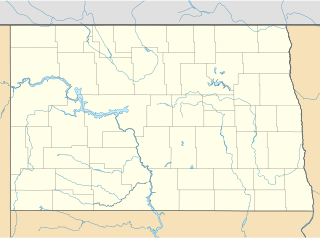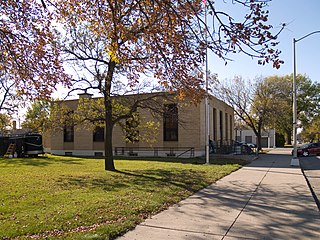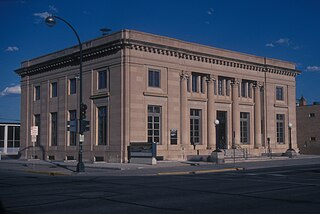
The Lower Sioux Agency, or Redwood Agency, was the federal administrative center for the Lower Sioux Indian Reservation in what became Redwood County, Minnesota, United States. It was the site of the Battle of Lower Sioux Agency on August 18, 1862, the first organized battle of the Dakota War of 1862.

Red River Valley University was a private liberal arts college located in Wahpeton, North Dakota, and affiliated with the Methodist Church. The university opened in 1893, and operated independently until 1905, when limited funds forced the closure of the Wahpeton campus. The university's trustees then forged an affiliation agreement with the University of North Dakota (UND), and reopened the school on the UND campus as "Wesley College."
Inyan Ceyaka Otonwe, also called Little Rapids or simply Inyan Ceyaka, was a summer planting village of the Wahpeton Dakota on the Minnesota River in what is now Louisville Township, Minnesota, United States. Located near present-day city of Jordan, the village was occupied by the Wahpeton during the early nineteenth century, and likely before. Burial mounds indicate that possible ancestors of the Dakota lived at the site as early as 100 CE. The site was listed on the National Register of Historic Places in 1999 for having local significance in the theme of archaeology. The unmarked site is preserved within the Carver Rapids unit of the Minnesota Valley State Recreation Area.

The United States Customs House and Post Office-Pembina was built in 1932. It was designed by the Office of the Supervising Architect under James A. Wetmore. It was listed on the National Register of Historic Places in 1989.

The U.S. Post Office-Hettinger in Hettinger, North Dakota, United States, is an example of Starved Classicism architecture. Also known as Hettinger Post Office, it was built during 1937-1938 and was listed on the National Register of Historic Places (NRHP) in 1989.

The U.S. Post Office-Carrington in Carrington, North Dakota, United States, also known as Carrington Post Office is a post office building that was built in 1932. It was listed on the National Register of Historic Places in 1989.

The U.S. Post Office-Langdon, also known as Langdon Post Office, in Langdon, North Dakota, United States, is a post office building that was built in 1937. It was listed on the National Register of Historic Places in 1989.

The Dickinson Post Office in Dickinson, North Dakota, is a post office building that was built in 1916. It was expanded to the east in 1965–66. It was listed on the National Register of Historic Places in 1989 as U.S. Post Office-Dickinson.

The Grafton Post Office in Grafton, North Dakota, United States, is a Colonial Revival building completed in 1932. It was listed on the National Register of Historic Places as U.S. Post Office-Grafton in 1989.

The Grassy Butte Post Office in Grassy Butte, North Dakota, United States, is a Ukrainian-type log building that was built by Carl Jagol and others in 1914. It was used as a post office for 49 years, until 1963, and was listed on the National Register of Historic Places in 1980, at which time it was owned by the McKenzie County Historical Society.

The Lisbon Post Office in Lisbon, North Dakota, United States, is a post office building that was built in 1939. It was listed on the National Register of Historic Places in 1989 as U.S. Post Office-Lisbon.

The Oakes Post Office in Oakes, North Dakota, United States, is a post office building that was built in 1935. It was listed on the National Register of Historic Places in 1989 as U.S. Post Office-Oakes.

The New Rockford Post Office in New Rockford, North Dakota, United States, is a post office building that was built in 1939. It was listed on the National Register of Historic Places in 1989 as U.S. Post Office-New Rockford.

The Rugby Post Office in Rugby, North Dakota, United States, is a post office building that was built in 1940. It was listed on the National Register of Historic Places in 1989 as U.S. Post Office-Rugby.

The Old U.S. Post Office in Williston, North Dakota, United States, is a former post office building that was built in 1915. It was listed on the National Register of Historic Places in 1979.

Haxby & Gillespie was an architectural firm from Fargo, North Dakota. R. J. Haxby and William D. Gillespie were the partners. The firm "produced a number of important buildings throughout North Dakota." They designed many notable public, educational, commercial, and church buildings, in North Dakota, Minnesota, and Montana.

William F. Kurke (1889–1965) was a prolific architect in North Dakota.

The Leach Public Library in Wahpeton, North Dakota was built in 1923. It was listed on the National Register of Historic Places in 1990.

The Wahpeton Hospital on Dakota Avenue in Wahpeton, North Dakota was built in 1911. It has Classical Revival architecture.

The Federal Building and U.S. Post Office at 657 2nd Ave. in Fargo, North Dakota, was built in 1969-70. It was listed on the National Register of Historic Places in 2021.
















